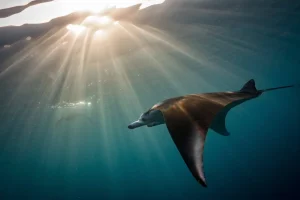Dive with Manta Rays in Komodo, Indonesia
Essential facts for your manta ray encounter – the majestic gentle giants of the sea.
Immerse yourself in the awe-inspiring realm of manta rays as you explore the pristine waters of Komodo, Indonesia. These majestic gentle giants of the sea captivate divers with their elegance and presence. In this comprehensive guide, we delve deeper into the world of manta rays, sharing essential facts and intriguing details that will enhance your manta ray encounter.
Gliding elegantly through the sea, manta rays are a sight to behold. Measuring 4-7 meters, diving with manta rays can be intimidating. But despite their jaw-dropping size, they are docile creatures that will amaze anybody.
Here are some essential facts to bear in mind when diving into the world of manta rays:

What Is A Manta Ray?
The manta is the most giant ray in the world. It is closely related to stingrays, with their flattened body and long tail, and to sharks, for their cartilaginous skeletons.
However, there are only two types of manta rays:
- Reef Manta: average width 5 meters (18 feet). This is the species you’ll find in Komodo.
- Giant Manta: average width 7 meters (23 feet).
These two species have their distinguishing features and characteristics, but share the same diamond-shaped body and wing-like pectoral fins, laterally placed eyes, and wide frontal mouths.
The Extraordinary Manta Ray: A Fascinating Overview
Manta rays, with their flattened bodies and long tails, belong to the same family as stingrays and share some characteristics with sharks. The world hosts two distinct species: the Reef Manta, averaging 5 meters in width, and the Giant Manta, spanning an average of 7 meters. These fascinating creatures boast diamond-shaped bodies, pectoral fins reminiscent of wings, lateral eyes, and wide frontal mouths.
Habitat and Habits
Giant manta rays prefer the open oceans, while their reef counterparts inhabit shallower coastal waters. Despite their formidable size, manta rays are not dangerous to humans. They lack a poisonous sting and exhibit non-aggressive behavior, often curiously approaching divers and performing acrobatic displays.
Where Do They Live?
As their name suggests, the giant manta ray is found in open oceans, whereas the reef manta ray lives in shallower coastal waters.
Are Manta Rays Dangerous?
Every diver’s dream is of one day having a manta ray encounter – better yet, to swim side by side with them. But are manta rays dangerous? Not at all. Although they have a tail-like stingray, manta rays do not have a poisonous sting and are not aggressive, so relax. They are huge, but not dangerous.
Truth be told, they are known for being curious and for approaching divers, putting on impressive acrobatic shows.
Fun Facts
- They have the largest brain of all fish.
- Their name “manta” comes from the Spanish for “blanket” after their appearance, but also indicates a blanket used traditionally to catch them.
- If they stop swimming, they’ll sink.
- They have personal identifying spots under their bellies, much like our fingerprints.
- They jump out of the water. Scientists still don’t know why. To eliminate parasites from their bodies or to perform a dazzling courtship ritual? One thing’s for sure; they make a big belly-flop splash!

The Fascinating World of Manta Rays: Beyond the Surface
Delve into the depths of manta ray knowledge, including their diet and reproduction cycle:
Diet: Manta rays are filter feeders, consuming plankton, small fish, and microscopic organisms. Their uniquely structured mouths enable efficient feeding.
Reproduction: Manta rays give birth to live young after an internal gestation period. They usually produce one pup every 2-5 years, contributing to their vulnerability.
Are They at Risk of Extinction?
The manta ray’s population is rapidly declining on a global scale. Its most significant threats are overfishing, water pollution, and climate change. Because of its slow reproduction rate, it is doubtful that manta rays will recover – especially in unprotected areas.
IUCN’s red list of threatened species has classified both species – reef manta ray and giant manta ray – as “vulnerable” and at high risk of extinction.
Why Scuba Dive with Manta Rays in Komodo?
Komodo is situated in the Komodo National Park, a UNESCO heritage site. It is home to 25% of the world’s fish species and 15% of its coral.
Moreover, in 2014 the Indonesian government banned fishing and exporting manta rays. It is the largest sanctuary for manta rays and one of the few places where it is possible to encounter this species.
Dragon Dive Komodo is a strong advocate for promoting sustainable tourism and best dive practices – essential for the survival of manta rays and the habitat they live in.

Top Spots for Manta Ray Encounters in Komodo National Park
If you’re seeking reliable locations for manta ray sightings in Komodo National Park, there are several hotspots you won’t want to miss:
- Manta Alley (Southern Region): Known for its consistent manta ray activity, this site is a favorite among divers who want to witness these majestic creatures up close.
- Karang Makassar and Mawan (Central Region): These sites offer prime locations for encountering manta rays, providing a central meeting point for these gentle giants.
- The Cauldron (Northern Region): Situated in the north, The Cauldron is another great place where you can expect frequent manta ray appearances.
Exploring these spots increases your chances of a memorable encounter with manta rays while enjoying the natural beauty of Komodo National Park.
What Conditions Attract Manta Rays to Komodo During October through March?
During the months from October to March, manta rays are drawn to Komodo due to a combination of biological and environmental factors. This period marks an ideal time for divers to witness these majestic creatures in larger numbers.
Key Factors Influencing Manta Ray Presence:
Seasonal Movement: Mature manta rays migrate to central Komodo from October to December. This period aligns with their natural patterns, making the region a prime location for encountering these marine giants.
Access to Manta Alley: The renowned Manta Alley in the southern part of Komodo becomes easily reachable. This site is a hotspot for divers hoping to see mantas up close.
Plankton Blooms: From December through February, the wet season stimulates plankton blooms. These blooms are a rich food source, attracting migratory manta rays in vast numbers. Plankton blooms create an abundant feeding ground, drawing mantas from various regions.
Wide Distribution: The abundance of plankton leads to sightings of manta rays throughout the entire park. It’s not uncommon to observe multiple mantas — sometimes a dozen or more — in a single location.
In summary, the combination of migratory patterns, accessible dive sites, and rich feeding conditions makes October through March a prime time for manta ray encounters in Komodo.
Manta Ray Season in Komodo
For the best diving conditions, however, visit Komodo between June and September. But if your goal is to dive with manta rays, you might want to consider the season from October through March. During this time, mature manta rays gather in larger numbers, particularly in central Komodo from October to December.
Additionally, the famous southern site, Manta Alley, becomes easily accessible.
December to February: The wet season induces plankton blooms, attracting a significant number of migratory manta rays. This natural occurrence increases your chances of encountering these majestic creatures throughout the park.
Divers may even witness the rare ‘manta mating train’ courtship ritual, adding a spectacular element to your dive experience.
By aligning your visit with these seasonal patterns, you can enhance your adventure in the waters of Komodo.



